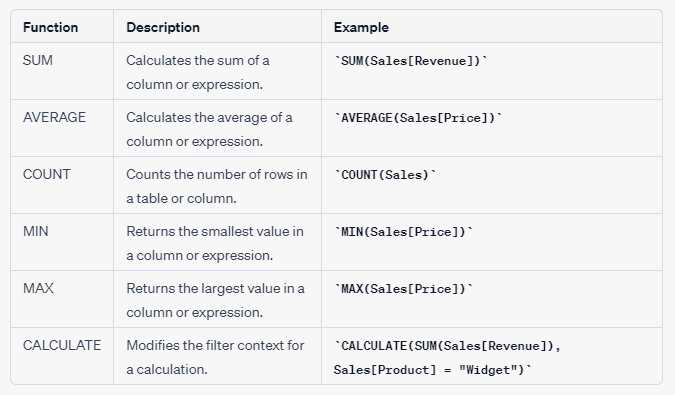Mastering Power BI DAX: A Beginner's Guide to Calculations
Written on
Introduction to DAX
Welcome! Today, we're exploring the DAX language utilized in Power BI for various calculations. But first, let me ask you—have you ever attempted to craft a complicated formula in Excel, only to be left scratching your head at a convoluted expression that sprawls across your screen? If that sounds familiar, you're not alone. Fortunately, DAX is here to simplify your life.
Understanding DAX
DAX, or Data Analysis Expressions, is the formula language used within Power BI to build calculations and formulas. While it shares similarities with Excel formulas, DAX offers additional functionalities that enhance its power and adaptability. Think of DAX as the more robust counterpart to Excel's simpler formulas.
DAX operates through a variety of functions—over 200 to be precise. While we won't cover each one today, we'll delve into some of the most commonly used functions and how to apply them.
Basic Syntax of DAX
Before we jump into examples, let's discuss DAX's fundamental syntax. Every DAX expression starts with an equal sign (=), followed by the function name and the required arguments. For instance, the SUM function is written as follows:
=SUM(Table[Column])
In this example, "Table" refers to the table's name, and "Column" indicates the column we wish to sum. With that in mind, let's move on to practical examples.

Photo by Jorge Rosal on Unsplash
Example 1: Using the SUM Function
Imagine we have a table named Sales with columns for Product, Price, and Quantity. To create a new column named Revenue that calculates total revenue for each product, we can apply the SUM function as follows:
=SUM(Sales[Price] * Sales[Quantity])
Here, we multiply the Price and Quantity columns to derive total revenue for each row, then sum these values.
Example 2: Calculating AVERAGE
Next, let's find the average price of each product using the AVERAGE function:
=AVERAGE(Sales[Price])
Simple and straightforward, right? The AVERAGE function behaves exactly as expected.
Example 3: Utilizing CALCULATE
The CALCULATE function is slightly more intricate but one of DAX's most potent tools. It allows for modifications to the filter context in calculations. For instance, to compute total revenue for a specific product category while excluding sales with a quantity less than 10, we can use:
=CALCULATE(SUM(Sales[Price] * Sales[Quantity]), Sales[Product Category] = "Widgets", Sales[Quantity] >= 10)
Here, we sum revenues for all sales in the Widgets category with a quantity of at least 10. The first argument specifies the expression to calculate, while the following arguments apply the necessary filters.
Pro Tips for DAX Mastery
- Utilize the DAX Formatter: This free online tool helps format your DAX expressions for improved readability. Your eyes will thank you!
- Implement Variables: DAX allows variable definitions, making your expressions more manageable and clear. Instead of repeating lengthy expressions, define a variable:
Sales Revenue =
VAR TotalSales = SUM(Sales[Price] * Sales[Quantity])
RETURN TotalSales
In this example, we define a variable called TotalSales to calculate total sales revenue, which we return as the expression result.
- Grasp Context: DAX calculations are evaluated within the data model's context. It's crucial to understand this context and how it influences your calculation outcomes. The CALCULATE function can help adjust the filter context.
Comparison of Common DAX Functions
To clarify the distinctions among popular DAX functions, here’s a comparison table:

Conclusion
DAX is a powerful language that enables complex calculations in Power BI. Although it may initially appear daunting with its extensive function library, practice and patience will guide you towards DAX proficiency. Remember to follow the basic syntax of =Function(Arguments) while crafting your expressions. Use the DAX Formatter for clarity, employ variables for simplicity, and always be aware of the context in which your expressions are evaluated.
As we wrap up this tutorial on using Power BI's DAX language for calculations, we've covered fundamental syntax, common functions, and professional tips to help you excel in DAX. Always remember to double-check your results and seek assistance if needed.
This video tutorial titled "How to use Power BI DAX - Tutorial" provides a comprehensive introduction to DAX, guiding you through the essentials of its use in Power BI.
In the video "Beginner Power BI DAX Functions Tutorial [Full Course]," you'll find an extensive course that covers a variety of DAX functions, perfect for beginners looking to deepen their understanding.
Sources
Thank you for reading this article! If you found it helpful, please show some love with a clap, comment, and be sure to follow.
About the Author
I'm Gabe A, an experienced data visualization architect and writer with over ten years in SQL, data analysis, and AI. I have a passion for topics such as Python, finance, and data visualization, and I aim to be a trusted voice in the data science community.
For more insights and updates in the creative AI field, consider following the Genesis AI publication.